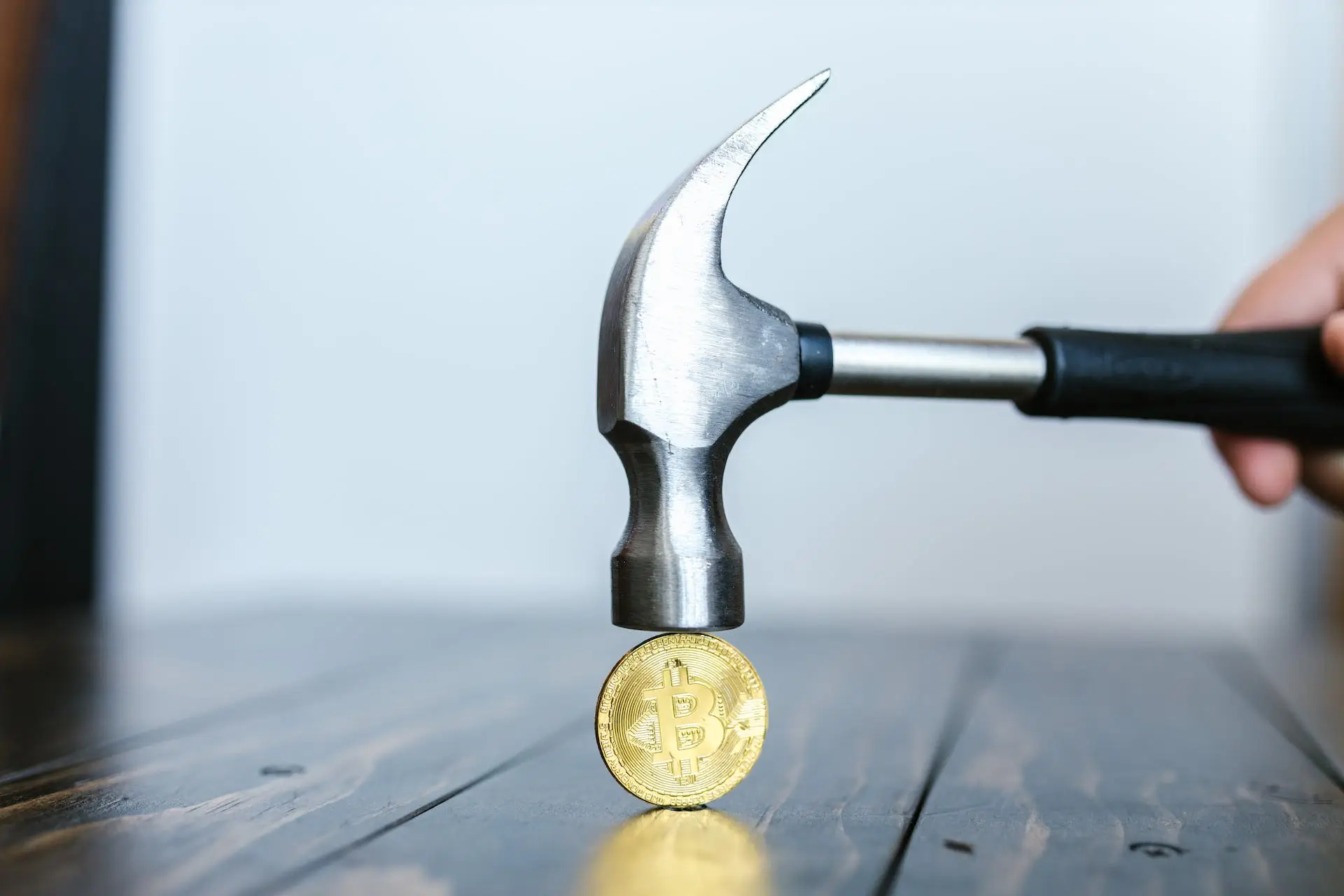What is a Bitcoin Halving Event?
We expect the next Bitcoin halving to occur on the 19th of April 2024. This highly anticipated event will mark the fourth Bitcoin halving since the creation of Bitcoin in 2009. The current reward for mining is 6.25 BTC per block. This will reduce to 3.125 BTC per block sometime in April 2024.
NOTE: A Bitcoin HALVING refers to a 50% reduction in the amount of bitcoin received as a reward for securing the network (mining).
In simple terms, a halving is a pre-programmed event that occurs every 210,000 blocks mined on the Bitcoin blockchain. It involves cutting the rewards received by miners in half. This will result in a decrease in the rate at which new bitcoins are created.
This mechanism is crucial for maintaining the limited supply of 21 million bitcoins. It is a key factor in determining its value and scarcity.
With each halving, the reward for mining decreases, causing a potential increase in demand and price for this leading cryptocurrency.
Many experts believe that the next halving could have a significant impact on Bitcoin’s value and shape its future as an emerging asset class. (I am not one of those)
Explanation of Bitcoin Halving
The Bitcoin Reward Halving is a key feature of the Bitcoin network. To understand its mechanism and purpose, let’s use an analogy.
Imagine a team of stewards at a music event. For every row of ticket holders, they seat they receive 50 free seats as payment for stewarding the event.
As the stewards move up the stands they receive fewer and fewer free seats ie 40 for the next row 30 for the next 20 for the next and so forth until the whole stadium has been filled.
This process doesn’t create new seats in the stadium but rather allocates seats in a ratio based on the total seats in the stadium and distributes it in line with the rate at which the stadium is filling up.
Importance of next Bitcoin Halving
The bitcoin halving is a major event in the cryptocurrency’s monetary policy that plays a crucial role in keeping it deflationary, meaning the value of bitcoins keeps going up over time—pretty cool, right?
One of the key things that makes Bitcoin deflationary is its limited supply. Unlike regular money that can be printed by governments, there will only ever be 21 million bitcoins in existence.
Yep, Satoshi set the limit in stone right from the start. (Technically if absolutely everyone agrees, the developers can increase this, but the odds are infinitely huge)
During the next bitcoin halving event, which happens roughly every four years, the number of new bitcoins created through mining gets cut in half.
So, miners end up receiving only half the amount of bitcoins for solving those complex math problems and adding new blocks to the blockchain.
Slowing down Inflation
The bitcoin halving effectively slows down inflation by reducing the rate at which new bitcoins are introduced into circulation. In other words, it helps to control the supply of bitcoins and prevent them from flooding the market.
This ensures that bitcoins remain a scarce and valuable asset, driving demand and increasing their value over time.
It’s important to note that during a bitcoin halving, new bitcoins are not technically created. Instead, the system allocates existing bitcoins among miners as part of their rewards. This further reinforces Bitcoin’s deflationary nature. The reason being that the system is not inttoducing new supply into circulation.
In essence, a halving event helps to maintain Bitcoin’s scarcity by controlling its “BTC per block” supply and preventing inflation. By doing so, it ensures that Bitcoin remains a valuable store of wealth for users and investors alike.
As such, it plays an integral role in supporting the long-term viability and success of the Bitcoin network.
A Brief Overview of Previous Halvings
To understand the significance of the upcoming Bitcoin halving, it is important to first look back at the previous three halvings and their impact on the world’s leading cryptocurrency.
The first Bitcoin halving took place in 2012, approximately three years after the creation of Bitcoin by Satoshi Nakamoto. At that time, the block reward for miners was reduced from 50 bitcoins per block to 25 bitcoins per block.
This event marked a significant milestone in the history of Bitcoin. It showed that Satoshi designed the digital currency with a finite supply in mind.
Following the first halving, there was a surge in demand for bitcoins as investors saw its scarcity and potential for value appreciation. This led to a significant increase in price, with bitcoin reaching an all-time high of $1,000 in late 2013.
Four years later, in 2016, came the second halving event where the block reward was further reduced from 25 bitcoins per block to 12.5 bitcoins per block. This brought about another surge in demand and price, with bitcoin reaching its peak at nearly $20,000 towards the end of 2017.
The impact of these two halvings cannot be understated. They not only increased interest and investment in Bitcoin but also solidified its position as a legitimate asset class. Furthermore, they also highlighted one of Bitcoin’s key features – its ability to resist inflation due to its controlled supply.
The 3rd halving in 2020 May was no different, as previously roughly a year after the halving, bitcoin hit yet another high of around $58k.
As we approach the third halving event, which is expected to take place in April 2024, many wonder what impact it will have on the price and adoption of Bitcoin.
Some experts predict that history will repeat itself and we can expect another surge in demand and price following this event. (Will the Bitcoin price hit $100k in 2025?)
Only time will tell how this upcoming Bitcoin halving will affect the future price of Bitcoin.

What does “Bitcoin Halving” Mean?
Bitcoin halving refers to the process by which the rewards for mining a block on the Bitcoin blockchain are reduced by half. This occurs approximately every four years and is part of the protocol designed to limit the total supply of Bitcoin to 21 million coins.
This reduction in mining rewards also has an impact on Bitcoin’s inflation rate, as it decreases over time until all 21 million coins have been mined.
This event is significant because it highlights the scarcity and limited supply of Bitcoin, which may potentially increase its value in the long term.
Purpose of the Bitcoin Halving
The purpose of the bitcoin halvening is to slow down the rate at which new bitcoins are created and introduced into circulation. The bitcoin network does this by reducing the reward given to miners for verifying and adding transactions to the blockchain.
Decreasing the supply of new bitcoins helps maintain its scarcity and can potentially increase its value over time.
Additionally, it also serves as a mechanism to control inflation and ensure that bitcoin remains a deflationary currency.
Controlling Inflation
The bitcoin halving is an event that occurs approximately every four years, where the amount of new bitcoins created each day is cut in half. This has a direct impact on inflation because it limits the supply of new bitcoins entering the market.
With a smaller supply of bitcoins, demand for them may increase, causing their value to rise. This controlled release of new bitcoins ensures that they do not flood the market and decrease in value due to oversupply.
As a result, the bitcoin halving helps to maintain a stable level of inflation in the cryptocurrency market.
Maintaining Scarcity
The halvening, also known as the Bitcoin halving, is a scheduled event that occurs approximately every four years within the Bitcoin protocol. It signifies the reduction of the reward for mining a new block on the blockchain, cutting it in half.
Consequently, instead of receiving the usual amount of Bitcoin for verifying transactions, miners only receive half.
One fascinating aspect of Bitcoin is its limited supply, set at a maximum of 21 million coins. The halvening plays a significant role in maintaining this scarcity. Reducing the mining reward, slows down the introduction of new bitcoins into circulation, helping to prevent inflation.
The network has released more than 95% of total bitcoins. The halvening continuously decreases the rate of new supply, thereby prolonging the time it takes to reach the maximum supply of 21 million.
As miners mine more bitcoins and add them to circulation, their scarcity intensifies. This occurs because each subsequent halvening further diminishes the amount of new supply, making it more challenging for miners to acquire fresh bitcoins.
As the demand for these limited coins continues to grow, their scarcity becomes even more pronounced.
Overall, the halvening ensures that Bitcoin remains scarce by meticulously controlling its supply and preventing inflation.
This characteristic makes it an attractive store of value and investment for those seeking protection against inflation or the potential devaluation of traditional currencies.
How does the Halving Affect the Miners’ BTC per Block Reward?
The upcoming halving event is going to have a significant impact on miners’ block rewards. Right now, miners receive 12.5 bitcoins for solving a block, but that’s going to decrease to 6.25 btc per block after the next halving.
So, they’ll be making less money, and unfortunately, some might even have to shut down their operations.
But here’s the thing, mate. With each halving, the supply of new bitcoins decreases. That means there could be a higher demand for bitcoin since it’s becoming scarcer. So, even though the block rewards are going down, mining might still be profitable.
On top of that, the halving also affects the competition among miners. With fewer rewards up for grabs, there might be fewer miners trying to solve blocks. We could wait longer for transactions to confirm as a result.
To sum it up, the halving is going to cut miners’ block rewards and potentially affect their profit. It also has an impact on the value of Bitcoin and the competition among miners on the network.

When is the Next Halving Happening?
You can not predict Bitcoin Halving dates with exact precision but you can with at least 99% certainty calculate the next Bitcoin halving date within a day or so.
Every bitcoin halving will happen roughly 4 years apart.
Date and Time Frame so far
| Halving | Year | Block Height | Block Reward | Date |
| 0 (Genesis Block) | 50.00000000 BTC | January 3, 20096:15:05 PM UTC | ||
| 1 | 2012 | 210,000 | 25.00000000 BTC | November 28, 201203:24:38 PM UTC |
| 2 | 2016 | 420,000 | 12.50000000 BTC | July 9, 20164:46:13 PM UTC |
| 3 | 2020 | 630,000 | 6.25000000 BTC | May 11, 20207:23:43 PM UTC |
| 4 | 2024 | 840,000 | 3.12500000 BTC | Apr 19, 202405:35:00 PM UTC (PROJECTED) |
Comparison to previous halvings
Remember that past performance is not necessarily an indication of future profits, but it does however paint a healthy picture in this instance!
Time intervals between halvings
Bitcoin halvings take place approximately every four years and are triggered by the addition of 210,000 blocks to the blockchain. This process occurs at an average block time of one every 10 minutes, leading to a halving event every four years.
This time frame is encoded in Bitcoin’s protocol, guaranteeing a maximum limit of 21 million bitcoins in circulation.
Impact on price
Bitcoin Halvings have historically exerted a significant influence on its price, triggering remarkable surges each time. Following the initial Halving in 2012, the price skyrocketed exponentially, surpassing all expectations.
Subsequently, after the second Halving in 2016, Bitcoin’s value surged once more, enhancing its appeal as an investment opportunity.
It is crucial to bear in mind that past performance does not guarantee future outcomes. However, a discernible trend of heightened interest and demand has emerged, propelling prices after each halving event.
This can be attributed to the reduction in the issuance of new Bitcoins, rendering them scarcer. As scarcity ensues, people’s desire to acquire them intensifies, further driving prices skyward.
Potential Impact on the Crypto Market
Commentators have had all sorts of theories on the impact of a Bitcoin halving on the crypto market. Ultimately there are many factors such as price, development, security and sentiment.
Increased scarcity
Some will argue that the bitcoin halving increases the scarcity of bitcoin but this is not strictly true. However, whilst bitcoin is released into the open market, the price is based on supply and demand.
Yes, the available supply in the open market is slightly increased every 10 minutes, but this does not mean it is being sold on the open market.
Possible Price Increase
We do not simply have a set “deflation rate” for every BTC per block that we add into the ecosystem. It is much more complicated. There are some factors such as user sentiment and regulatory changes that have a much bigger influence than simply the BTC per block increase.
Effects on Supply and Demand
There is a slight increase in supply but at present, we already have more than 20 million of the possible 21 million bitcoins in circulation.
I would argue that we are already at a point where the supply and demand of Bitcoin are regulated more by buyers and sellers than by fresh Bitcoin being released from its locked-in state.

Frequently Asked Questions About the Bitcoin Halvening
What Historical Patterns Can We Identify in Bitcoin’s Price Movements Surrounding Halvings?
Many investors are interested in historical data to identify patterns or trends in Bitcoin’s price leading up to and following halving events. When we analyse past behaviour can provide insights into potential market movements.
How Does the Market Typically React to Bitcoin Halving Events?
Understanding the market sentiment and reactions of traders and investors during previous halvings is crucial. This question aims to explore whether there are consistent reactions and if the market has learned from past experiences.
What Innovations or Changes in the Bitcoin Ecosystem Have Resulted from Previous Halvings?
Bitcoin halvings often spur innovation and adaptation within the ecosystem. Exploring any technological advancements, changes in market infrastructure, or new developments that emerged as a result of past halvings provides a broader perspective on the event’s impact.
What Role Does Institutional Investment Play in Bitcoin Halving Cycles?
As institutional interest in Bitcoin grows, understanding how these entities navigate and contribute to the market during halving events is essential. This question explores the evolving role of institutional investors in shaping Bitcoin’s landscape around halvings.
Are There Any Unique Factors or Challenges for Miners During the Next Halving?
Beyond the basic understanding of reduced block rewards, this question delves into specific challenges or opportunities miners might face during the next halving. Factors such as energy consumption, mining hardware, and geographic distribution can be explored to provide a more nuanced perspective.
The Recap
The next bitcoin halving is an event that occurs approximately every four years in the world of cryptocurrency. It involves cutting the reward for mining new bitcoins in half, resulting in a reduction of new supply.
This event is expected to have a significant impact on the price of Bitcoin. We base this on past halvings which have resulted in a surge in value.
While experts have differing opinions on the exact effect, many believe that the next halving will drive up demand. This will ultimately lead to a rise in Bitcoin’s value.
How will you deal with the halving event? Do you care? Leave a comment below and share your opinion with us!






